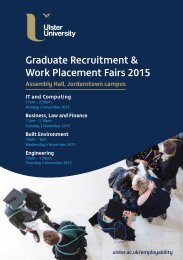Public Attitudes to Peace Walls (2015)
1RRkqqy
1RRkqqy
You also want an ePaper? Increase the reach of your titles
YUMPU automatically turns print PDFs into web optimized ePapers that Google loves.
<strong>Public</strong> <strong>Attitudes</strong> <strong>to</strong> <strong>Peace</strong> <strong>Walls</strong> (<strong>2015</strong>)<br />
Survey Results<br />
Ulster University<br />
<strong>Attitudes</strong> <strong>to</strong>wards safety are also important <strong>to</strong> understand. Although only 21% of respondents<br />
reported an improved sense of safety as a result of the peace process, three quarters of all<br />
respondents <strong>to</strong> the survey reported that their communities were very or fairly safe (Table 7). There<br />
was, however, a difference between Protestants and Catholics with notably more Catholics (32%)<br />
than Protestants (24%) feeling very safe, while many more Protestants (16%) than Catholics (5%)<br />
said they felt very or fairly unsafe.<br />
Table 7: How safe do you feel in your community? (by religion)<br />
Total (%) Protestant (%) Catholic (%)<br />
Very safe 28 24 32<br />
Fairly safe 48 45 50<br />
Neither safe nor unsafe 12 15 11<br />
Fairly unsafe 6 11 3<br />
Very unsafe 3 5 2<br />
Don’t know/not sure 2 1 2<br />
Previous research has shown that safety and security are two issues (Byrne, et al 2012) that<br />
influence how local residents view processes <strong>to</strong> remove peace walls. Those that reside closest<br />
<strong>to</strong> the walls want <strong>to</strong> be assured that their homes and families will not be at risk and that<br />
in the absence of a barrier, they will remain safe and not vulnerable. However, the 2014 NI<br />
<strong>Peace</strong> Moni<strong>to</strong>ring report noted that sectarian violencewas problematic and that ‘in working<br />
class communities: paramilitaries are still very much part of <strong>to</strong>day’s reality’ (Nolan, 2014).<br />
Furthermore, the recent announcement from the PSNI Chief Constable, that cuts <strong>to</strong> the PSNI<br />
would ‘fundamentally change how and where policing is delivered’ (NIPB, 2014), could have<br />
unpredictable effects on community confidence in the capacity of alternative policing structures<br />
<strong>to</strong> reduce and respond <strong>to</strong> community fears around safety in the absence of the peace walls.<br />
3.2 Relations with ‘the other’ community<br />
Social separation on the basis of community background remains considerable (Table 8). Over<br />
a fifth of both Catholics and Protestants reported that they never meet people from outside<br />
their own community. The general pattern of inter-community contact is very similar in both<br />
communities. What is clear, however, is that interaction is less unusual among people under 55,<br />
with 51% of adults under 35 reporting that they interacted often or very often contrasting with<br />
38% among respondents over 55. Whereas 55% of women interacted often with people who did<br />
not share their own community background, this was true for 43% of men.<br />
12




